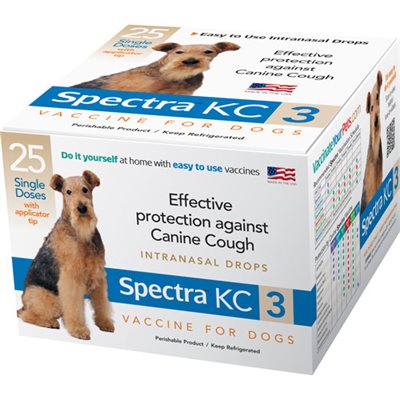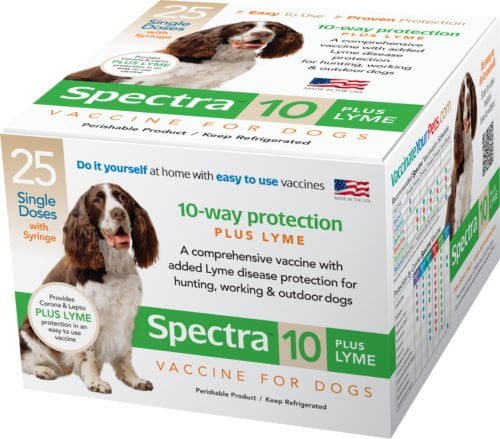

Twist and remove needle from syringe and attach enclosed applicator tip. Withdraw entire contents into the syringe. Aseptically rehydrate the vaccine cake with 1 ml of sterile diluent supplied. DescriptionĬanine Spectra KC3™ vaccine is a combination of immunogenic, attenuated strain of CAV2 and CPIV propagated in cell line tissue cultures with an avirulent live culture of B.bronch.ĭirections and dosage: Open the syringe by twisting or tapping the cap against a hard surface to break the heat weld. For more information regarding efficacy and safety data go to. The duration of immunity has not been determined. This product has been shown to be effective for the vaccination of healthy dogs 8 weeks of age or older against Bordetella bronchiseptica (B.bronch), canine parainfluenza (CPIV), and canine adenovirus type 2 (CAV2). KEEP PRODUCT REFRIGERATED Canine Spectra KC3 Indications

If you have any questions or concerns, you should always visit or call your veterinarian - they are your best resource to ensure the health and well-being of your pets.Canine Adenovirus Type 2-Parainfluenza-Bordetella Bronchiseptica Vaccine This will assure that your dog remains healthy and is appropriately vaccinated. It should be administered yearly for dogs considered by your veterinarian to be at risk.Īll dogs should be examined by a veterinarian at least yearly and a complete history and risk assessment should be performed.
Canine influenza is a relatively recently described disease and a relatively new vaccine. Dogs exposed to these environments should be vaccinated yearly. Boarding facilities, dog shows, dog classes, and parks where dogs play are all potential risks. 
These diseases are respiratory infections and as such are transmitted from dog to dog.
Vaccination against canine cough includes bordetella and parainfluenza vaccines. Vaccination against leptospirosis should be considered for dogs who are exposed to wildlife environments like ponds, or when urban and rural wildlife share the environment with your dog. While exposure and infection do not always result in disease, dogs considered at risk should be vaccinated and tested annually. The populations of deer are expanding and with them the incidence of exposure. It is transmitted by deer ticks associated with white tail deer. Lyme disease is no longer limited to the Northeastern United States. How can you determine your dog’s risk of infection? These vaccines generally provide a shorter length of protective immunity, and dogs that are at risk for infection should be vaccinated every year. The risk assessment should also take lifestyle into consideration. The indication for these vaccines should be based on a risk assessment that looks at local and regional incidence of the disease. While all dogs are at risk for core diseases and must be vaccinated-risk of exposure, likelihood of infection, and severity of disease should be evaluated when making non-core vaccine recommendations. Non-core vaccines protect against diseases that do not meet the core vaccine description. While not all vaccines carry a label that indicates they are effective for 3 years, current recommendations for core vaccines are that after the completion of an initial series, dogs should be revaccinated every 3 years. Rabies vaccines are sometimes administered more often based on state and provincial regulations. Duration of immunity from these vaccines has been proven to be at least 3 years. Historically, these vaccines were recommended yearly but this is no longer the case. In summary, core diseases are the more contagious and severe diseases.Ĭore vaccines provide long term immunity, making yearly vaccination unnecessary. One core disease-rabies, can be transmitted to humans with potentially deadly results. These diseases are commonly fatal or extremely difficult to treat effectively. There are two general groupings of vaccinations: those that target “core” diseases and those that target “non-core” diseases.Ĭore vaccinations prevent diseases that are extremely widespread in their distribution and are easily transmitted. Not all dogs need to be vaccinated for all diseases all the time. 
It's not just a matter of more vaccines but also better vaccines that are more specific, provide longer protection, and allow your veterinarian to make recommendations appropriate for your pet. Diseases that, just a few years ago, were epidemics are now less common. Vaccines keep your dog protected from serious infectious diseases. Veterinary science, in conjunction with industry, has done a great job developing vaccines that are very safe and effective preventive measures.








 0 kommentar(er)
0 kommentar(er)
